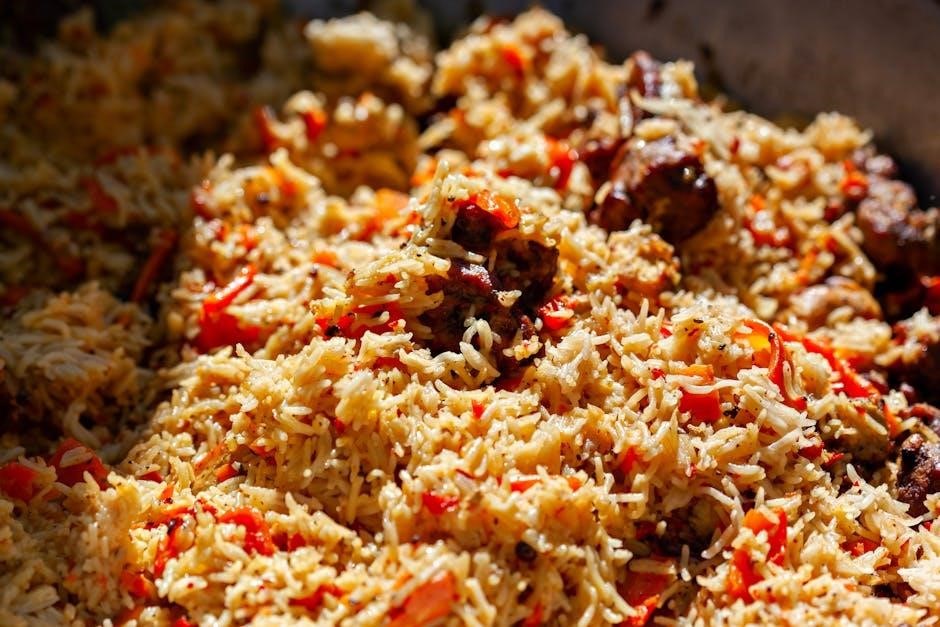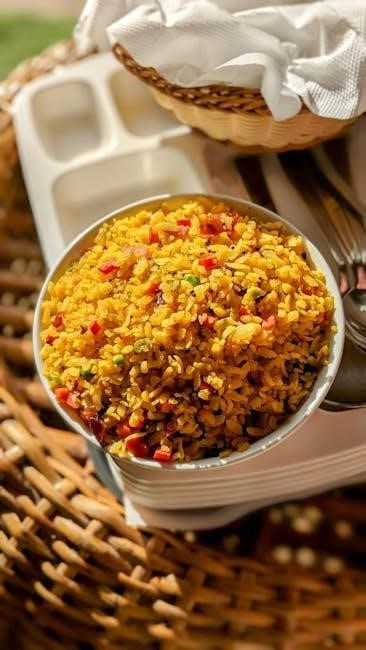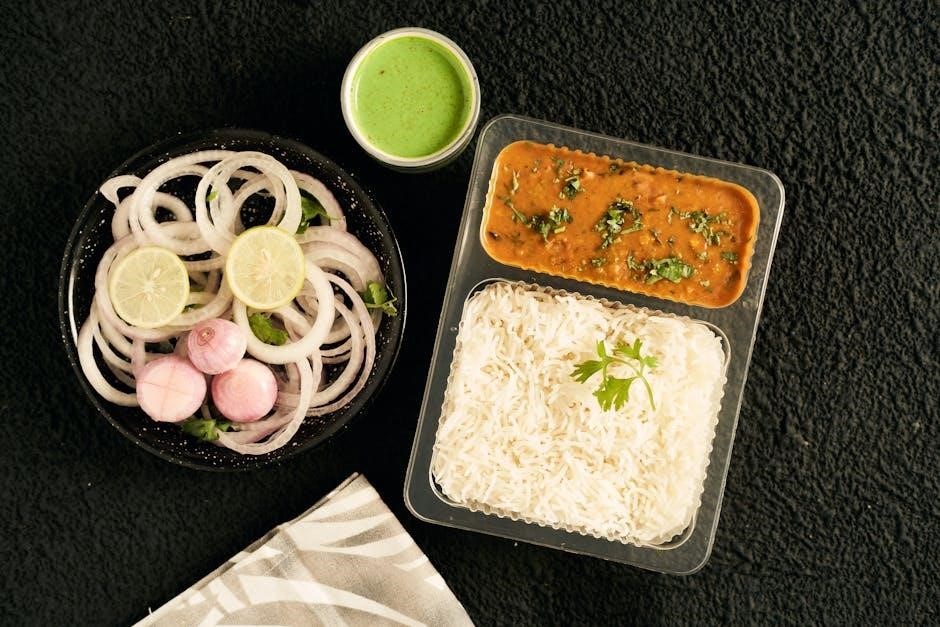Mahatma Basmati Rice Instructions: A Comprehensive Guide
Unlock the secret to perfectly cooked Mahatma Basmati rice with our comprehensive guide. We’ll walk you through each step, from essential ingredients to serving suggestions. Achieve fluffy, flavorful rice every time, impressing your family with your culinary skills. Master this staple dish today!
Understanding Basmati Rice
Basmati rice, especially the Mahatma brand, is a long-grain rice known for its delicate aroma and distinct flavor. Originating from the foothills of the Himalayas, it’s prized for its fluffy texture and non-sticky grains when cooked properly. Understanding its unique characteristics is crucial for achieving the best results.
Mahatma Basmati rice distinguishes itself through its aging process, which reduces moisture content and concentrates its aromatic compounds. This contributes to its superior taste and texture. Unlike other rice varieties, Basmati expands lengthwise rather than widthwise during cooking, resulting in long, separate grains.
Choosing Mahatma Basmati ensures you are starting with a high-quality product. This brand adheres to strict quality control measures, guaranteeing consistent results. Knowing these fundamental aspects sets the stage for mastering the art of cooking perfect Basmati rice, unlocking its full potential in a variety of dishes, from simple side dishes to elaborate culinary creations.
Essential Ingredients and Equipment
To embark on your journey of cooking flawless Mahatma Basmati rice, gathering the necessary ingredients and equipment is paramount. The core ingredient, of course, is Mahatma Basmati rice itself. Opt for a package that is properly sealed to ensure freshness and aroma. Beyond the rice, you’ll need water, preferably filtered for the purest taste. A pinch of salt will enhance the flavor profile.

In terms of equipment, a saucepan with a tight-fitting lid is essential. This will trap steam and ensure even cooking. A fine-mesh sieve or colander is required for rinsing the rice, removing excess starch and contributing to a fluffier texture. A measuring cup is crucial for achieving the correct water-to-rice ratio, a key factor in the final outcome. Finally, a fork will be needed for fluffing the cooked rice, separating the grains and preventing them from sticking together. Having these elements readily available will streamline the cooking process and set you up for success.
Rinsing the Rice: A Crucial First Step
Rinsing your Mahatma Basmati rice before cooking is an absolutely critical step, often overlooked but essential for achieving that coveted fluffy texture. This simple process removes excess surface starch, which, if left unaddressed, can cause the rice grains to stick together during cooking, resulting in a gummy or mushy consistency. Think of it as preparing a canvas before painting; rinsing sets the stage for optimal results;
To effectively rinse the rice, place the measured amount into a fine-mesh sieve or colander. Position the sieve under a stream of cold, running water. Gently agitate the rice with your hand, allowing the water to flow through and carry away the starch. Continue rinsing until the water runs clear, or nearly clear. This usually takes a few minutes. Don’t be tempted to skip this step; the difference it makes in the final texture is remarkable. By diligently rinsing, you’re ensuring each grain cooks separately, achieving that desirable light and airy basmati texture.
Water Ratio for Perfect Basmati Rice
Achieving the perfect water ratio is paramount to cooking fluffy and delicious Mahatma Basmati rice. Too much water, and you’ll end up with soggy rice; too little, and it will be undercooked and potentially burnt. Finding that sweet spot is key. A generally recommended ratio is 1 ¾ cups of water for every 1 cup of dry Basmati rice. This ratio allows for sufficient absorption during cooking, resulting in tender, separate grains.
However, slight adjustments might be necessary based on your stovetop, pot, and personal preference. Some cooks prefer a 1:1.5 ratio for a drier result. Experimentation is encouraged! After rinsing your rice, combine it with the measured water in a saucepan. Bring the mixture to a boil over medium-high heat. Once boiling, reduce the heat to low, cover the pot tightly with a lid, and simmer. The precise cooking time will depend on your stove, but typically it’s around 15-20 minutes. Resist the urge to lift the lid during cooking, as this can release steam and disrupt the cooking process. With practice, you’ll master the art of perfect basmati rice!
Cooking on the Stovetop: Step-by-Step
Cooking Mahatma Basmati rice on the stovetop is a classic and reliable method for achieving perfectly cooked grains. First, rinse your measured rice under cold water until the water runs clear. This removes excess starch and helps prevent stickiness. Next, combine the rinsed rice with the correct water ratio (typically 1 ¾ cups water per 1 cup rice) in a medium saucepan. Add a pinch of salt for flavor, if desired.
Bring the mixture to a rolling boil over medium-high heat. Once boiling, immediately reduce the heat to the lowest setting possible. Cover the pot tightly with a lid to trap the steam. Simmer gently for 15-20 minutes, or until all the water has been absorbed. It’s crucial not to lift the lid during this time, as this releases steam and affects the cooking process. After the cooking time, remove the pot from the heat and let it stand, covered, for another 10 minutes. This allows the rice to steam further and ensures even cooking. Finally, fluff the rice gently with a fork before serving. Enjoy your perfectly cooked Basmati!
Cooking Time and Temperature
Achieving perfectly cooked Mahatma Basmati rice hinges on understanding the relationship between cooking time and temperature. The initial phase involves bringing the rice and water to a rolling boil over medium-high heat. This rapid heating is crucial for initiating the cooking process and ensuring even distribution of heat throughout the rice. However, maintaining this high heat throughout the entire cooking process will result in scorched rice at the bottom of the pan and undercooked grains on top.
Once the water reaches a boil, the key is to immediately reduce the heat to the lowest possible setting. This gentle simmer allows the rice to cook slowly and evenly, absorbing the water gradually without burning. The ideal simmering time typically ranges from 15 to 20 minutes, but it can vary slightly depending on your stovetop and the specific type of Basmati rice. After simmering, it’s equally important to let the rice stand, covered, for 10 minutes. This resting period allows the residual steam to finish cooking the rice, resulting in a light, fluffy texture. Remember, patience and low heat are your allies in achieving perfect Basmati rice every time.
Checking for Doneness: Visual Cues
Determining when your Mahatma Basmati rice is perfectly cooked relies on recognizing specific visual cues. The primary indicator is the complete absorption of water. Carefully tilt the pot; if no visible liquid remains at the bottom, it suggests the rice has absorbed all the water. However, don’t solely rely on this. The surface of the rice should appear evenly cooked, with individual grains that look plump and elongated. Avoid stirring excessively during cooking, as this can disrupt the process.
Another key visual cue is the appearance of small steam holes on the surface of the rice. These holes indicate that steam is escaping, signifying that the rice is nearing completion. To confirm, gently use a fork to lift a small portion of rice from the center of the pot. The grains should be tender and easily separate. If the rice appears too wet or mushy, it requires a few more minutes of simmering. Conversely, if the rice seems dry and hard, add a tablespoon or two of water and continue simmering for a short while longer. Remember, practice makes perfect in identifying these visual cues.
Fluffing the Rice: Achieving the Right Texture
Fluffing your Mahatma Basmati rice is a crucial step in achieving the perfect texture. After the cooking time is complete and the rice has rested, gently take a fork and begin to separate the grains. The goal is to create light, airy, and distinct grains, avoiding a clumpy or mushy consistency. Insert the fork into the rice and lift upwards, allowing the steam to escape and the grains to separate naturally. Be careful not to overwork the rice, as excessive stirring can break the grains and lead to a sticky texture.

Work your way around the pot, ensuring you reach all areas. If you notice any clumps, gently break them apart with the tines of the fork; The fluffing process also helps to distribute any remaining moisture evenly throughout the rice. For best results, use a long-handled fork and a light touch. Remember, the key is to create a delicate and separated texture, enhancing the overall eating experience. Proper fluffing elevates the presentation and palatability of your Basmati rice, making it a delightful accompaniment to any meal. Enjoy the fluffy perfection!
Serving Suggestions and Pairings
Mahatma Basmati rice, with its delicate aroma and fluffy texture, is incredibly versatile and pairs well with a wide array of dishes. For a classic pairing, serve it alongside Indian curries like butter chicken, vegetable korma, or lamb rogan josh. The rice acts as the perfect canvas to soak up the rich and flavorful sauces.
In Middle Eastern cuisine, Basmati rice is a staple, complementing dishes like kebabs, shawarma, and tagines. Its light and airy texture provides a delightful contrast to the savory and often spiced meats. Consider adding saffron or dried fruits and nuts for an extra touch of elegance. For a lighter meal, serve it with grilled fish, roasted vegetables, or a vibrant salad. The subtle flavor of Basmati rice won’t overpower the other ingredients but will instead enhance their natural tastes.
Experiment with different herbs and spices to customize your Basmati rice to suit your meal. A sprinkle of fresh cilantro or a dash of turmeric can add a pop of color and flavor. Whether you’re preparing an elaborate feast or a simple weeknight dinner, Mahatma Basmati rice is a reliable and delicious choice.
Troubleshooting Common Issues
Even with the best instructions, cooking perfect Basmati rice can sometimes present challenges. One common issue is mushy rice, which usually indicates too much water. If this happens, try cooking the rice uncovered over low heat to allow excess moisture to evaporate. Conversely, if the rice is too dry or undercooked, add a tablespoon or two of water and continue steaming for a few more minutes.
Another frequent problem is rice sticking to the bottom of the pot. To prevent this, ensure you’re using a heavy-bottomed pot and maintaining a low simmer. If sticking occurs, resist the urge to stir vigorously, as this can make the rice gummy. Instead, gently loosen the rice from the bottom with a fork.
Unevenly cooked rice can result from inconsistent heat distribution. Make sure your stovetop burner is the correct size for your pot and that the heat is evenly distributed. If you’re still experiencing issues, consider using a rice cooker, which is designed to cook rice perfectly every time. Don’t be discouraged by occasional mishaps; with practice and these troubleshooting tips, you’ll master the art of cooking flawless Basmati rice.
Storing Leftover Cooked Rice

Proper storage is crucial for maintaining the quality and safety of leftover cooked Basmati rice. To prevent bacterial growth, it’s essential to cool the rice quickly. Spread the rice out on a baking sheet or shallow dish to allow it to cool down within an hour. This rapid cooling minimizes the time the rice spends in the temperature danger zone, where bacteria thrive.
Once the rice is cooled, transfer it to an airtight container. This will prevent it from drying out and absorbing odors from the refrigerator. You can store the rice in the refrigerator for up to four days. When reheating, add a tablespoon of water per cup of rice to help rehydrate it and restore its fluffy texture. Reheat thoroughly until it’s steaming hot throughout.

For longer storage, you can freeze cooked Basmati rice. Portion the cooled rice into freezer-safe bags or containers. When ready to use, thaw the rice in the refrigerator overnight or use the defrost setting on your microwave. Remember to reheat thoroughly before serving. Properly stored, leftover cooked Basmati rice can be a convenient and delicious addition to future meals.